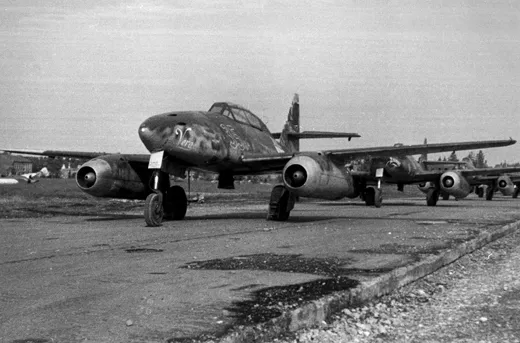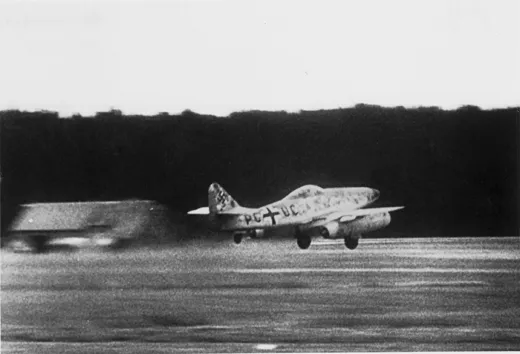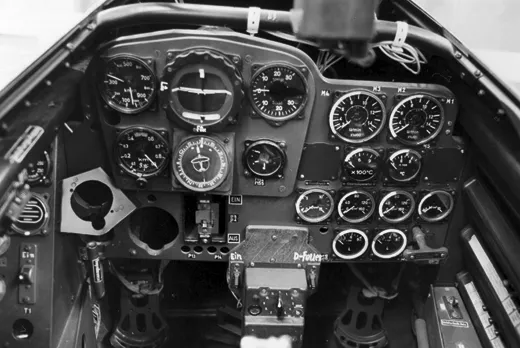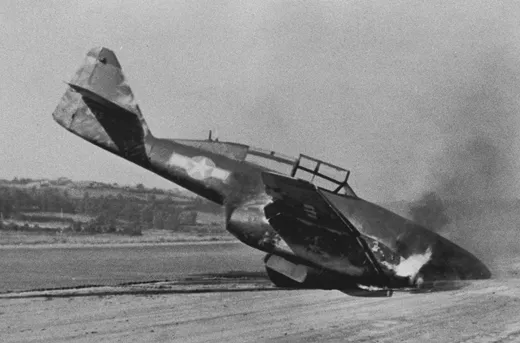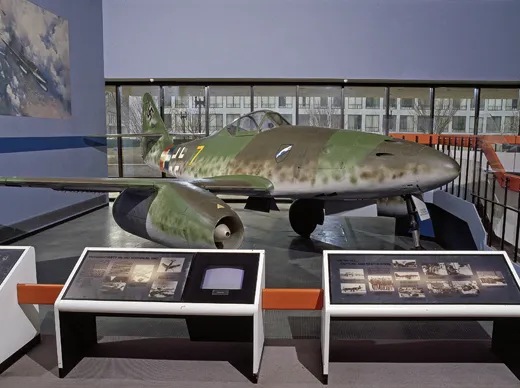Stormbird
Stormbird
/https://tf-cmsv2-smithsonianmag-media.s3.amazonaws.com/filer/stormbird_388-nov06.jpg)
BOB HAMMER RECALLS THE DAY ten 18-wheel tractor trailers dumped the pieces of five Messerschmitt Me 262 Stormbird jet fighter reproductions in a hangar near the city of Everett, Washington. The pieces had been trucked in from Texas, where an initial attempt to build the aircraft had ended in lawsuits. “Parts everywhere—parts, parts, parts,” says Hammer, a retired Boeing engineer. “You never saw such a mess.”
That was in December 1998. For Hammer and a small team of volunteers, it was just the start of a long process to put the Me 262 back in the air. Now, the Me 262 Project, as it is called, has logged numerous successful flights and delivered two of the German aircraft, with a third nearing completion. With their project, Hammer and his team have brought the world’s first production jet fighter back to life.
The Me 262s could have wreaked havoc on U.S., British, and Russian forces in World War II had there been more of them and had those that made it into the action had reliable engines.
The Germans needed about five years to get the Me 262 off the drawing board and into the air. It took more than twice that to get a copy up for its first flight, late in 2002. The first effort to make Me 262 copies, which began in the early 1990s and involved warbird fan Stephen L. Snyder and a Texas aircraft restoration company, dissolved in acrimony. Snyder called on Hammer to take over the work. The effort was barely under way when Snyder died in the crash of his North American F-86 jet fighter in 1999. Years of problems with engine generators, brakes, and landing gear assemblies followed.
“At times we thought this was stupid and should just give up,” says Jim Byron, another retired Boeing executive who pitched in. “But that’s not the Boeing mentality, so we kept plugging along.”
Hammer and Byron—along with dozens of volunteers— worked doggedly on the difficult aircraft. Hammer is something of an aviation prodigy, a youthful-looking, sandy-haired 67-year-old who favors faded blue jeans and T-shirts. He spent 38 years at Boeing, working as chief engineer on the 757, among other projects. He has also built an array of aircraft in his spare time, most recently a four-seat Seafire amphibian that was named Grand Champion Seaplane at the 1998 Experimental Aircraft Association airshow in Oshkosh, Wisconsin. On the Me 262, he handles most of the engineering challenges, while Byron, an avuncular 68-year-old with white hair, runs the office and manages the volunteer team.
The Me 262 Project is headquartered in a non-descript hangar at Paine Field, a large airfield north of Seattle. Aviation maintenance giant Goodrich has a facility there, and Boeing uses the field to roll out new 747s and 777s for their first flights after they leave the nearby wide-body plant. On the second floor of the hangar is a warren of offices and meeting rooms, the walls covered with Me 262 photographs and drawings. Downstairs, a crowded shop holds a completed Me 262 and more in assembly—wings, engines, and shelves of parts scattered around.
Hammer and his team took over the Me 262 project in late 1998, and their the first task was to finish Vera, a derelict Me 262 that Steve Snyder had found sitting outside the Willow Grove Naval Air Station near Philadelphia. Vera had been captured after World War II and flown as an experimental aircraft until it was sent to Willow Grove, where it sat on static display for many years. In exchange for the right to use Vera (the nickname came from the sister-in-law of a pilot who had helped capture Me 262s after World War II) as a template, Snyder had agreed to restore the aircraft to static-display quality. Snyder’s death nearly ended the Me 262 Project. But Hammer talked with two buyers he had lined up for Me 262 reproductions—the Messerschmitt Foundation in Munich, Germany, and a retired judge in Arizona named Louis Werner—and they agreed to finance both the restoration of Vera and the construction of two reproductions of the old warplane.
The goal of the Me 262 Project was not to make an identical copy of the original aircraft; some concessions have been inevitable. The original Junkers Jumo jet engines, for instance, were famously prone to breakdowns and often good for no more than 10 hours of flight (although some built with higher quality steel reached a service life of 200 hours or more). So the engines used by the Me 262 Project are the reliable, proven GE J85 engines found on many business jets. The Me 262’s nose gear was notoriously fragile, with the Germans losing many aircraft to nose wheel collapses. Hammer fashioned a brace for the gear that eliminated the problem. And all the aircraft have modern radios and navigation gear.
Overall, though, the team has stuck as closely as possible to the real thing. While aluminum would have been lighter, the skin was made of steel, like the skin on the originals—a concession to wartime aluminum shortages. The instrument panel was made from plywood, as were the landing gear doors. The use of Phillips-head screws seemed like a reasonable substitute, but guests from the Messerschmitt Foundation, who planned to make a flying copy of the Me 262 the centerpiece of their collection of Willi Messerschmitt-designed airplanes, insisted that slotted screws, identical to those in the original, be used. “We only need 500, but had to buy 15,000 of them,” Byron chuckles, comparing his request for slotted screws to walking into a modern RadioShack and asking to buy television tubes. “They said ‘We’ll do it,’ but once they set up to make slotted-head screws, they had to crank them out like yards of sausage.”
Hammer’s group needed nearly four years to transform its pile of parts into a flying Me 262. Problems abounded. At one point, for instance, the team was confounded by the controllers for the engine generators, which provide electricity to the aircraft. “It was the worst kind of problem—an intermittent one,” says Hammer. The controllers would occasionally burn out a relay for no apparent reason, shutting down power to the aircraft. “It was driving me nuts.” Finally, Hammer found a retired electronics engineer who agreed to pore over the controllers’ complex wiring schematics (“They looked like a road map from here to Greece,” says Hammer). After two days, the engineer unearthed a fault in the original Air Force wiring diagram, which caused the project team to miswire the controllers.
The team also faced headaches in getting the brakes to work properly (modern disc brakes replace the failure-prone drum brakes on the original), and in balancing the 2,500 pounds of thrust from the GE J-85 with the flying characteristics of the Me 262, which was designed for a less-powerful engine. “People think that once you have an airframe, you’re 90 percent of the way there,” says Hammer. “Hell no. That’s only about 15 percent…. The rest is integrating all the rest of this stuff so it works together.”
Hammer came to greatly admire the Stormbird. The name (Sturmvogel in German) refers to the fighter-bomber version of the aircraft, but seems more fitting than the fighter’s name, Schwalbe, which means Swallow. “I was really impressed with the way the airplane was designed for easy assembly,” he says. “They were building this thing in woods and caves and everywhere else, so parts were built all over the place and then put together.” The cockpit “tub,” for instance, was a single assembly that could be dropped into a fuselage. Wing and control components were similarly designed for easy construction and assembly.
Finally, on December 20, 2002, aviation history was made…again. Wolfgang Czaia, a former pilot for the modern German Luftwaffe (Czaia still flies Lockheed F-104 Starfighters as part of the Starfighters Airshow Demonstration Team) and a retired 757/767 captain for American Airlines, flew an Me 262 dubbed White One at Paine Field. For 35 minutes, Czaia made gentle turns and tested the airplane’s stall characteristics while keeping the gear down. “A pleasure to fly,” Czaia wrote in his flight test report. “Overall, a great first flight.”
On the next flight, January 18, the gear was retracted. Right away Czaia had problems, with two red lights on his instrument panel. An observer in a chase airplane reported the gear up and doors closed. Czaia cycled the gear again. This time the nose wheel dropped only part way while the main gear stayed up. Finally, he activated an emergency system that used compressed nitrogen to blow the gear down. Success—or so Czaia thought.
As Czaia touched down, the main landing gear on the aircraft’s left side collapsed. Within seconds, the speeding Me 262 had careered off the runway and over an embankment. “That was a pretty rough ride,” recalls Czaia. “CNN had a camera in the cockpit that day and caught the whole thing.”
The horrified ground crew dashed to the crash site and found Czaia clambering out of the jet, unhurt. The airplane wasn’t so lucky. In addition to the collapsed gear, one wing was crunched and the engine nacelles had substantial dents.
The team eventually traced the problem to a landing gear actuator assembly that had been machined slightly out of tolerance in Texas. The gear had performed flawlessly during hundreds of ground tests, but the stress of an actual landing caused it to buckle. Within a week, Hammer had tracked down an original landing gear actuator and started work on duplicating it.
By the summer of 2004, White One was flying again—this time without any problems. The second Me 262, Tango-Tango, was completed in the summer of 2005, and last fall was disassembled and flown to Munich, Germany, in a 747 freighter, where it was the hit of the Berlin Airshow. Tango-Tango also flew for a Family Day at the Messerschmitt Foundation. Organizers expected 3,000 people; 90,000 showed up. A third aircraft should be flying this fall, with the last two scheduled for completion when the Me 262 Project finds buyers.
After that, no additional Me 262s will be built. During the breakup between Steve Snyder and the Texas company that first worked on the aircraft, several key jigs for making wings and fuselages were lost, so the Everett group lacks the tools needed to build one from scratch. Instead, they’re tackling the restoration of a piston-powered fighter, a Messerschmitt Bf 109F that had crashed in Russia during World War II.
Meanwhile, the Me 262 Project still has three Me 262s for sale at about $2 million each. “It took far longer and cost far more money than I ever would have imagined, but we got here,” says Hammer.
